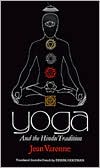

 |

|

The average rating for Yoga and the Hindu Tradition based on 2 reviews is 4 stars.
Review # 1 was written on 2015-03-06 00:00:00 Aldo Freitas Aldo FreitasAs a long-time and fairly devoted yoga practitioner, and someone who feels spiritually touched by yoga, I have often wondered exactly how our modern-day, Western yoga relates to any kind of yoga actually practiced, currently or historically, in India -- or if it does at all. This book does a great job of answering that question in terms of the traditional Hindu spiritual practices, but leaves off around the 1970s (it was published in 1976), therefore omitting how yoga has developed in the last 40 years. (Admittedly, 40 years is a mere drop in the bucket of centuries that yoga has existed, but spans a great chunk of time since its export to the West. I plan on looking elsewhere -- namely, The Goddess Pose, just published by Michelle Goldberg -- to get to the bottom of that.) Varenne's book does exactly as it's title would lead one to believe: explores yoga's relation to the Hindu tradition. And it does a great job. The book is divided into three sections. The first sets the foundation of Hindu spiritual philosophy and the human's place within the Hindu understanding of time and the universe. I found this to be immensely educational and Varenne does a great job of staying CONCISE and yet not seeming to dumb it down. Hindu philosophy (according to him) is notoriously complex and multi-faceted, and I appreciated his ability to keep it to the most important and relevant bits. I also appreciated getting this first real taste of Hindu philosophy from a well-educated Westerner's POV, because many points of Hinduism veer widely from normative religious belief in the West, and Varenne does a good job of steering the Judeo-Christian mind away from points of possible confusion (over competing beliefs about "heaven," for example). The second part introduces yoga as a mystic tradition within Hinduism, practiced by only a very few men (women are excluded) who are spiritually called and who find a guru. He discusses the position of the sadhu (yogi/mystic) in Indian society and the 8-fold path of reaching liberation that yogic tradition sets out. Some of that will be familiar enough to serious Western yoga practitioners (pranayama, asana, meditation, and so on). Interestingly, few of the poses (asanas) associated with yoga are mentioned in any of the ancient texts on yoga (the lotus position and head-stand are all that Varenne comes up with). This section is almost technical, using as source material the canonical Hindu and yogic texts (The Yoga Sutras, The Yoga Darshana Upanishad, etc.), which are CONFOUNDINGLY brief on certain matters, and basically walks the reader through each of the 8 steps on the path. Leading the way to the third section of the book. Which is a further explication of exactly HOW the yogi is supposed to achieve liberation by following the 8-fold path, wherein Varenne attempts to fill in the gaps left by the ancient texts by using Tantric and Kundalini philosophies. It addresses the channels of the subtle body and the chakras as a way of understanding the body as analogue to universe -- and therefore how the body can lead to liberation from itself, a central tenet of yoga. Of particular interest to me was Varenne's underlining of the fact that the subtle body has never had anything but a spiritual/metaphysical meaning in Hindu philosophy, that Indians have understood the biological workings of the human body as long as (or longer than) Westerners and know perfectly well that these channels do not ACTUALLY carry breath to different parts of the body. Rather they are to be understood as mystical channels carrying a mystical breath or life force (prana) into the parts of the body. I mention this only because I've read the Yoga Sutras - written around the time of Christ - and wondered exactly how these parts of the body were meant to be understood. (Willy-nilly New Age use of these metaphysical aspects of the subtle body only add to the confusion, in my opinion.) Varenne concludes with a quick historical overview and discussion of yogis famous to interested Westerners in the 20th Century - Ramakrishna and Aurobindo in particular - and finally ends with a snobby little French dissection of the "hippy" culture which was the cause of the "recent" fascination (remember this was written in 1976) with yoga, about which he is clearly somewhat disgusted. All in all, I thought this book was very informative - dense in places but more than made up for by its brevity and conciseness. Excluding the complete Yoga Darshana Upanishad, which is included as an appendix, the volume is less than 200 pages. Highly recommended to spiritual yoga practitioners yearning for more historical understanding of the yoga tradition. As I said earlier though, if you're wondering where the Warrior poses, dolphin, pigeon, chair, goddess, wheel and all the other hundreds of standard yoga poses taught in Western classes today originate, you'll have to look elsewhere. |
Review # 2 was written on 2016-12-30 00:00:00 Thomas Pinto Thomas PintoVery good |
CAN'T FIND WHAT YOU'RE LOOKING FOR? CLICK HERE!!!